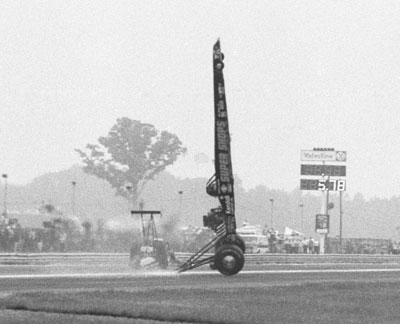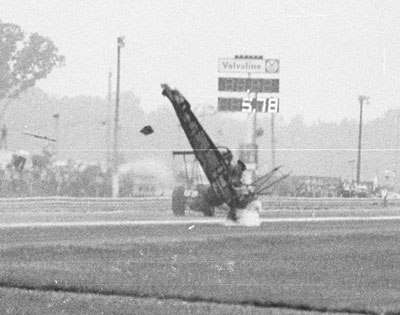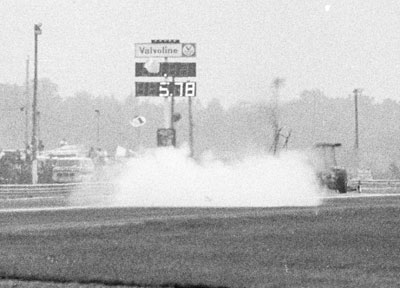

Top Fuel blowovers, Part 1
 |
The streamliner series was, predictably, well-received, as I think we all have a soft spot in our hearts for experimentation and oddball efforts. As you may recall, very few of the streamliners or other aero-influenced Top Fuelers were very successful, the lone exception, of course, being Don Garlits’ Swamp Rat XXX that carried him through the 270-mph barrier to the world championship in 1986. It also carried him further into drag racing lore with “The Blowover,” his Did-that-just-happen? backward flip at the 1986 Summernationals. “Big Daddy” walked away unscathed from that memorable moment but, incredibly, suffered another a year later with Swamp Rat 31 in Spokane, Wash., that put a real hurting on “the Old Man” and convinced him to retire (for, like, the 100th time) until his brief comeback in 1992.
Although Garlits immediately deduced that his blowovers were the result of air getting trapped under the big nose of his cars, turning what might have been a pulse-pounding wheelie into a heart-stopping backflip, that doesn’t explain the epidemic of blowovers of conventional cars that followed in the 1990s.
The anatomy of the modern-day blowover was pretty simple. For varying reasons, the car would get the front tires into the air well after leaving the starting line, and air pressure at that speed would work to hold the car aloft and lever it backward. Fortunately, in a large number of cases, the gyroscopic effect of the rear wheels turning would give the car a half-twist so that it landed backward – but upright – on the track, thus limiting injury mostly to hurt feelings and a very bent race car.
If you look back on the history of the sport (as I will in a few paragraphs), there weren’t a whole lot of overbackward wheelies – as they were called before the term “blowover” was borrowed from Unlimited Hydroplane boat racing – before the 1990s, so I have to point my nonexpert finger of blame toward five factors: more power, better clutches, better track prep, more effective rear wings, and the abandonment of the wheelie bar.
Obviously, it takes power to yank the front wheels off the ground, and yanking ‘em up at the starting line has never been a problem for most, and it usually never developed into a problem for the driver unless he kept his boot to the firewall. A simple lift from the throttle would bring the front end crashing to the ground, with the worst result being maybe a bent axle or A-arm. However, even the most powerful Top Fuelers didn’t have the zots to lift the front end farther downtrack, but as power grew and the nitro engineers learned how to harness that power with multistage clutches that didn’t lock up until the car was well under way and NHRA crews did a better and better job of expanding the good traction downcourse and more downforce was added to the rear of the car through the laid-back and double- and triple-element rear wings, you suddenly had the recipe for a midtrack wheelstand. At that speed, air was now pushing hard on the underside of the car, and sometimes – most times, it seemed – there was just no stopping the upward movement. And because the Top Fuel crowd had largely stopped running wheelie bars – Garlits ditched his in 1985 – there was no mechanical apparatus to control the rotation. Again, that’s just the hypothesis of this armchair crew chief, but I think it’s pretty accurate.
 I racked my memory for early examples of overbackward wheelies in Top Fuel history, and a few quickly leaped to mind that can be found in the gallery at right. There was Jimmy King’s wild ride in the King & Marshall slingshot at the 1970 Nationals in Indy, when he turned it upside down just off the line in the very first pair of the first round of eliminations against Bob Ivett and the Corr Electric AA/FD. King got a lot of ribbing for that flip, and one of his wise-guy crewmembers famously welded a caster wheel atop the roll cage before the next outing. (When Sy Sidebotham found and restored the car in 2001, the caster was faithfully put back on.)
I racked my memory for early examples of overbackward wheelies in Top Fuel history, and a few quickly leaped to mind that can be found in the gallery at right. There was Jimmy King’s wild ride in the King & Marshall slingshot at the 1970 Nationals in Indy, when he turned it upside down just off the line in the very first pair of the first round of eliminations against Bob Ivett and the Corr Electric AA/FD. King got a lot of ribbing for that flip, and one of his wise-guy crewmembers famously welded a caster wheel atop the roll cage before the next outing. (When Sy Sidebotham found and restored the car in 2001, the caster was faithfully put back on.)
I remember seeing in Drag Racing USA Steve Reyes’ great shot of Jack Martin’s moon shot in his rear-engine car at the Grand Premiere at Lions Drag Strip in early 1972, and Steve was kind enough again to send it to me for use here. As Steve remembers, “Upon landing, the car slid upside down, and the engine was running at about 10,000 rpm. Everyone, of course, started to run to the car, and then the blower went boom -- not a big boom, just a good bang. That scared the heck out of the folks who were rushing to the car.” You can see this incident in the amazing clip (fast forward to the 45-second mark) posted on YouTube here that shows what a crashtacular event that was: Stan Shiroma losing the roof on the Midnight Skulker; big fires for Omar Carruthers and Bob McFarland; and, most spectacularly, Gary Burgin launching the Braskett & Burgin Vega into a midtrack wheelstand and crossing into Joe Winter’s lane, then being nerfed out of the way and the car going onto its roof.
Although it’s a Funny Car, few can forget Dennis Geisler’s backflip of Bert Berniker’s Hindsight rear-engine flopper at the 1975 Winternationals, and, finally, there was Dick Allard’s wild ride in the Sundowners Top Fueler at the 1980 Grandnational outside of Montreal. Based on their early flippage -- well before halftrack - I believe all of these were created by power and not aero forces; the blowovers of the '80s and '90s usually occurred around halftrack, sometimes later.
The video clip at right shows one of the wildest wheelies I’ve ever seen. Shot at the 1973 Popular Hot Rodding Championships in Martin, Mich., it shows Division 3 regular Paul Longenecker launching into a wheelie that grows bigger as he stays on the gas trying to beat Jim Bucher. Finally, the car goes vertical, then pirouettes down the track on the rear rubber alone like a ballerina, spinning on its axis what looks like four times before crashing back to the track. It’s an amazing piece of footage.
I’m sure there are others – and I’m equally certain that the Insider Nation will alert me to such – but I really can’t remember any at this point until “Big Daddy’s” Englishtown acrobatics, Saturday, July 12, 1986.
The day before, Garlits had run the quickest elapsed time in Top Fuel history, a 5.343, and was intent on backing it up for the national record the next day. Garlits and crew chief Herb Parks came loaded for bear with a stout load of nitro. They were running Darrell Gwynn, Garlits’ hungry young nemesis at the time, and “Big” wanted to strap it to the kid he called “the Wolf.”
A contributing factor to Garlits’ blowover may well have been a leaking fuel nozzle that Parks worked frantically to fix as Garlits prepared to stage. The extra wait – Garlits said it felt like five or 10 minutes but in reality was probably less than one – no doubt burned a lot more fuel than expected, lightening the fuel load in the front-mounted fuel tank and disrupting the car’s balance.
 |
 |
 |
 |
 |
Almost from the launch, the front tires were up and just kept going as Garlits rode it for all it was worth before lifting, which wasn’t soon enough. The car stood straight up, twirled a half-turn, and miraculously landed back on all fours in a cloud of smoke as its momentum carried the car almost to the finish line with the rear tires still churning forward. When the car hooked, it headed back uptrack a few hundred feet before Garlits cut the power.
“I saw the car up about 3 feet, and I backpedaled it, but it was coming up too hard,” Garlits told National DRAGSTER. “As it was straight up in the air, I couldn't believe how it raises you off the ground; you get real high. Then I remember that first hard impact -- that was real tough -- then it was smooth; I couldn't believe it. I braced myself, and I floorboarded the engine [throttle], and it was very fortunate, because then, as the car was going backwards, probably, oh, a couple of hundred miles an hour, the wheels were spinning to make it go forward. It was even better than brakes. The car stopped in about 150, 200 feet.
“Then the car shot forward out of the smoke; y'see, I was still holding the throttle down because I was still disoriented, and so I'm holding the throttle down, and the car shoots out of the smoke, and I'm looking, and I'm looking at the starting line! I said, ‘My God, what's going on here?!’ So I still hadn't pulled off of the throttle, but I did then push the fuel-shutoff valve immediately, and then backed off the throttle. I couldn't steer it anymore because the steering was all jimmied up from the impact. It was just going where it wanted to; it was kinda making a slow left-hand turn, and I ended up right on the edge of the track where I went straight up. It came back to the point of origin.”
Other than a bruise on the inside of his right thigh where it hit the shift tower when the car landed on its side, Garlits was uninjured, and the car, surprisingly, suffered little damage, though he did withdraw it from competition (“Even I’m not that crazy,” he self-mocked when Steve Evans asked him if the car could continue at the event).
Asked about the effects of air on the spoon-shaped nose, Garlits admitted that it had been on his mind. “I was always worried about that and just what the outcome would be and how much time I would have to do something about it,” he said. “I found out: zero. I was helpless in there.”
And to the lack of wheelie bars, he confessed, “I should have put them on here already; it was stupidity on my part. The front end has been up several times, but not like this.”
Garlits repaired the car and ran it through mid-1987 before it ended up in the Smithsonian, then brought out a similar car, Swamp Rat 31 – still with no wheelie bars -- at the NHRA event in Brainerd in early August. Two weeks later, on Aug. 21 at an AHRA event in Spokane, it was déjà vu all over again for “Big Daddy” as SR31 also took flight at the top end, leaving him with two broken ribs, an injured back, and a totally destroyed race car. Garlits was making a test run with a new dual-element rear wing, a configuration that had found its way onto several top cars and that creates greater downforce.
"At about the 1,000-foot mark," related Garlits, "the front end came up suddenly, and I reached for the brake real fast -- because I'm programmed for that now -- but by the time I got the brake and pulled it back, the car was straight up in the air and turning overbackwards. The car went 215 mph through the lights upside down and backwards; 5.51 was the e.t., with the rear wheels tripping the e.t. lights after I had skidded the brakes as hard as I could, so [the car] was on a good pass."
Asked if he had any theories about what had been causing the wheelstands, Garlits answered, "The cars are light in the front, and they're going very fast. Once they lift the front end up a little bit, they ride on a cushion of air -- like an airfoil -- and it's hard to control. And my car with that big front end was even worse.
"Mandatory wheelie bars would help," he added. "That would have stopped it; it never would have gotten out of control like that."
Garlits’ blowovers were the only ones of the 1980s to that point, but the next decade would provide a rash of highlight-reel blowovers that caught the best of the sport unawares. We’ll look into a chronology of those next week.



















































